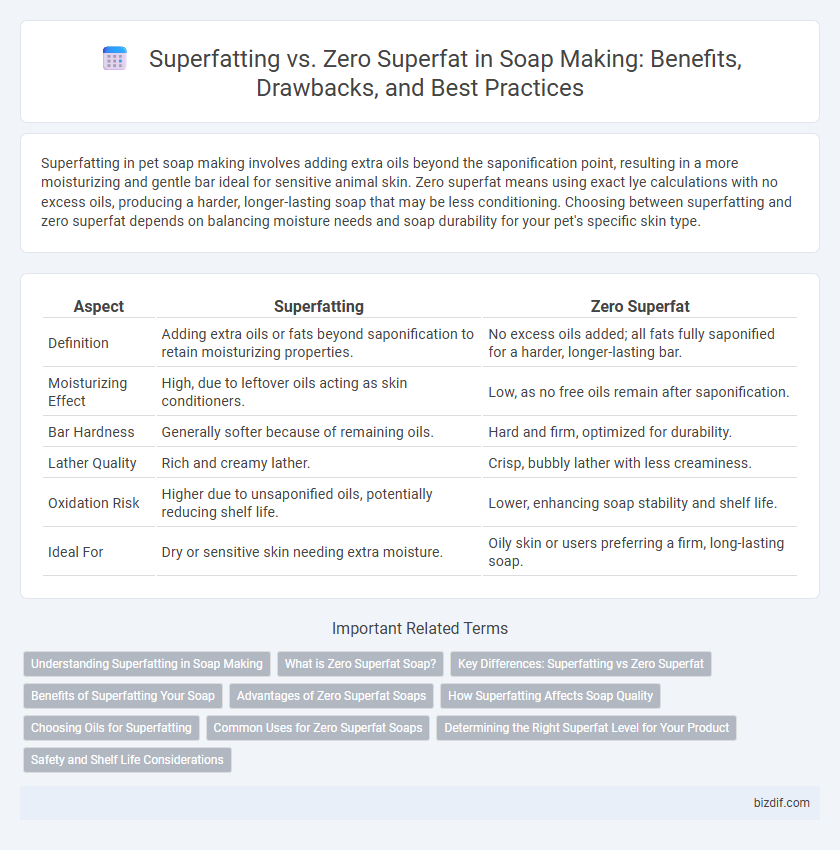Superfatting in pet soap making involves adding extra oils beyond the saponification point, resulting in a more moisturizing and gentle bar ideal for sensitive animal skin. Zero superfat means using exact lye calculations with no excess oils, producing a harder, longer-lasting soap that may be less conditioning. Choosing between superfatting and zero superfat depends on balancing moisture needs and soap durability for your pet's specific skin type.
Table of Comparison
| Aspect | Superfatting | Zero Superfat |
|---|---|---|
| Definition | Adding extra oils or fats beyond saponification to retain moisturizing properties. | No excess oils added; all fats fully saponified for a harder, longer-lasting bar. |
| Moisturizing Effect | High, due to leftover oils acting as skin conditioners. | Low, as no free oils remain after saponification. |
| Bar Hardness | Generally softer because of remaining oils. | Hard and firm, optimized for durability. |
| Lather Quality | Rich and creamy lather. | Crisp, bubbly lather with less creaminess. |
| Oxidation Risk | Higher due to unsaponified oils, potentially reducing shelf life. | Lower, enhancing soap stability and shelf life. |
| Ideal For | Dry or sensitive skin needing extra moisture. | Oily skin or users preferring a firm, long-lasting soap. |
Understanding Superfatting in Soap Making
Superfatting in soap making refers to the intentional addition of extra oils or fats beyond what the lye can saponify, resulting in a moisturizing and gentle bar. Zero superfat means using the exact amount of lye needed to fully convert oils into soap, producing a harder, less moisturizing bar. Understanding the balance of superfatting helps artisans control soap qualities like hydration, lather, and skin feel.
What is Zero Superfat Soap?
Zero superfat soap contains no excess oils beyond what fully saponifies, resulting in a harder bar with a lower risk of oily residue or rancidity. Unlike superfatting, which leaves some unsaponified oils for moisturizing properties, zero superfat soaps prioritize longevity and lather stability. This method requires precise calculations and thorough mixing to ensure complete saponification without compromising skin hydration.
Key Differences: Superfatting vs Zero Superfat
Superfatting in soap making involves adding extra oils or fats beyond the amount needed to react with lye, resulting in a moisturizing bar with leftover oils that enhance skin hydration. Zero superfat means all oils have fully saponified, producing a firmer, longer-lasting soap but potentially less moisturizing compared to superfat soaps. The key difference lies in superfatting providing extra nourishment and softness, while zero superfat emphasizes a balance between cleansing efficiency and soap durability.
Benefits of Superfatting Your Soap
Superfatting your soap enhances moisturizing properties by leaving extra oils that nourish and protect the skin, reducing dryness and irritation. It boosts the soap's gentleness, making it ideal for sensitive or dry skin types, while also improving lather quality and richness. This technique balances cleansing power with skin care, providing a luxurious and skin-friendly soap experience.
Advantages of Zero Superfat Soaps
Zero superfat soaps offer enhanced cleansing power by fully saponifying all oils, resulting in less residual oil on the skin and a more thorough removal of dirt and impurities. These soaps tend to have a longer shelf life due to the absence of unsaponified oils, reducing the risk of rancidity. Additionally, zero superfat formulations provide a consistent foam and texture, appealing to users seeking a clean, balanced lather without excess greasiness.
How Superfatting Affects Soap Quality
Superfatting in soap making involves adding extra oils beyond the saponification point, resulting in a higher oil content that enhances moisturizing properties and produces a gentler, creamier lather. This technique increases the soap's quality by improving skin hydration and reducing the risk of irritation, making it ideal for sensitive skin types. Zero superfat soaps, by contrast, contain no excess oils, which can lead to a harder, longer-lasting bar but may be less moisturizing and potentially more drying.
Choosing Oils for Superfatting
Selecting rich, nourishing oils such as olive, avocado, or shea butter is crucial when superfatting soap, as these oils remain unsaponified to provide extra moisturizing benefits. Superfatting requires precise calculation of oil quantities to ensure the right balance between lather and skin conditioning without compromising the soap's hardness. Zero superfat soap uses minimal or no extra oils, leading to a harder bar but less moisturizing properties, making the choice of oils essential for desired skin feel and performance.
Common Uses for Zero Superfat Soaps
Zero superfat soaps are widely used in medical and skincare applications due to their superior cleansing properties and reduced residue, making them ideal for sensitive or acne-prone skin. These soaps provide a higher lather and stronger detergent effect, which helps in removing oils and dirt more effectively than superfatted soaps. Commonly chosen for hospital environments and deep cleansing routines, zero superfat soaps offer a balance between thorough cleansing and minimal moisturizing.
Determining the Right Superfat Level for Your Product
Determining the right superfat level in soap making depends on desired moisturizing properties and lather quality, with typical superfat levels ranging from 0% (zero superfat) to 5%. Superfatting enhances skin nourishment by leaving extra oils unreacted, making it ideal for sensitive or dry skin formulations, while zero superfat creates a harder, longer-lasting bar but can be less moisturizing. Experimenting within this range allows soap makers to balance cleansing effectiveness and skin hydration tailored to specific product goals.
Safety and Shelf Life Considerations
Superfatting in soap making involves adding extra oils that remain unsaponified, enhancing moisturizing properties but potentially reducing shelf life due to increased risk of rancidity. Zero superfat soaps fully saponify oils, improving safety by minimizing free oils that can cause skin irritation and extending shelf stability. Careful balance between superfat level and ingredient selection is crucial for safe, long-lasting soap formulations.
Superfatting vs Zero Superfat Infographic

 bizdif.com
bizdif.com